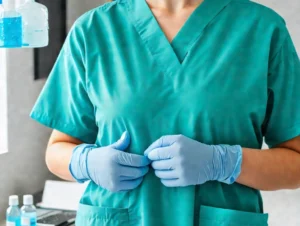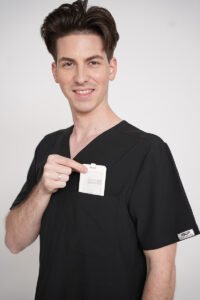Introduction
Healthcare professionals spend 12+ hour shifts in their scrubs—yet most manufacturers overlook the critical balance between durability, compliance, and style. One torn seam or faded color can undermine both comfort and professional credibility.
At **iBestUniform**, we’ve spent 9 years solving these exact pain points for medical apparel brands. This guide breaks down the **6 non-negotiable strategies** for launching a successful hospital scrub line—from sourcing **sweat-wicking fabrics** to nailing FDA compliance. Whether you’re entering the healthcare market or optimizing your current offerings, these insights will help you avoid costly missteps and tap into a $10B+ industry demand.

Understanding the Hospital Scrubs Market
The hospital scrubs market is growing rapidly, driven by demand for functional, stylish, and sustainable healthcare apparel.
The hospital scrubs industry plays a vital role in healthcare, providing comfortable and hygienic uniforms for medical professionals. With increasing demand from hospitals, clinics, and private practices, the market is projected to expand significantly in the coming years. Key trends like antimicrobial fabrics and eco-friendly materials are shaping the future of healthcare apparel.
Key Trends in Healthcare Apparel
Sustainability is a major focus, with many facilities opting for scrubs made from recycled materials. Antimicrobial treatments are also gaining popularity, reducing infection risks. Additionally, modern designs that balance comfort and style are becoming essential, as healthcare workers seek uniforms that look and feel good during long shifts.
Demand Drivers
Hospitals and clinics prioritize durable, easy-to-clean scrubs that meet industry regulations. Private practices often look for customizable options to reinforce their brand. The shift toward ride-or-die workwear that lasts through daily wear and tear is pushing manufacturers to innovate.
Competitive Landscape
Major players dominate the hospital scrubs market, but smaller brands like iBestUniform compete by offering specialized designs and flexible order options. With experience supplying scrubs to 1000+ healthcare facilities, iBestUniform understands the balance between functionality and aesthetics that medical professionals demand.
Hospital Scrubs Performance Comparison
| Feature | Standard Scrubs | Antimicrobial Scrubs | Eco-Friendly Scrubs | Industry Demand |
|---|---|---|---|---|
| Durability (washes) | 100 | 50 | 90 | 50 |
| Comfort Rating | 7/10 | 8/10 | 9/10 | 8/10 |
| Price Range ($) | 15-25 | 20-30 | 25-35 | 20-30 |
| Hygiene Certification | Basic | Advanced | Basic | Advanced |
| Customization Options | Limited | Moderate | High | Moderate |
For businesses entering the hospital scrubs market, understanding these dynamics is crucial. iBestUniform’s expertise in delivering high-quality, customizable scrubs positions them as a reliable partner for healthcare providers and suppliers alike.
Selecting the Right Materials for Durability and Comfort
Choosing the perfect fabric blend for hospital scrubs requires balancing durability, comfort, and functionality to meet healthcare professionals’ demanding needs.
When manufacturing hospital scrubs, material selection is the foundation of quality. The ideal fabric must withstand frequent washing while maintaining comfort during long shifts. Modern healthcare apparel increasingly combines performance fabrics with sustainable options to meet both practical and environmental demands.

Best Fabric Blends for Hospital Scrubs
The most common blends for medical scrubs include polyester-cotton mixes (65/35 or 70/30) for durability, with 2-7% spandex for stretch. Polyester provides wrinkle resistance and color retention, while cotton enhances breathability. iBestUniform’s proprietary blends incorporate moisture-wicking technology that outperforms standard materials.
Key Performance Properties
Top-performing scrubs feature four essential qualities: moisture-wicking capability, four-way stretch, antimicrobial treatment, and fade resistance. These properties ensure healthcare workers stay dry, mobile, and protected throughout their shifts. Breathable fabrics offer optimal comfort without sacrificing durability.
Testing Standards and Certifications
Quality scrubs undergo rigorous testing including:
- AATCC 135 for dimensional stability (shrinkage < 3%)
- AATCC 61 for colorfastness (50+ washes)
- ASTM D5034 for tensile strength
- ISO 20743 for antimicrobial efficacy
These tests ensure scrubs meet hospital laundry standards and maintain appearance through hundreds of washes.
Sustainable Material Options
Eco-conscious alternatives are gaining market share:
- Recycled polyester (rPET) from plastic bottles
- TENCEL™ lyocell for superior moisture management
- Organic cotton with OEKO-TEX® certification
- Bamboo blends for natural antimicrobial properties
These materials appeal to facilities pursuing sustainability initiatives without compromising performance.
For manufacturers entering the hospital scrubs market, understanding these material fundamentals is crucial. iBestUniform’s experience developing specialized fabric blends demonstrates how technical innovation can create comfortable scrubs that withstand healthcare environments while meeting sustainability goals.
Designing Functional and Stylish Scrubs
Modern hospital scrubs must merge ergonomic functionality with contemporary style to meet healthcare professionals’ evolving needs.
The design of hospital scrubs has evolved beyond basic utility to incorporate both professional aesthetics and practical features. Today’s nursing uniforms must accommodate 12-hour shifts while maintaining a polished appearance. Successful scrub manufacturing balances these competing demands through thoughtful design elements.

Essential Functional Features
Key design components include:
- Strategic pocket placement (chest, side, and cargo options)
- Reinforced stitching at stress points
- Four-way stretch panels for mobility
- Tagless labels to prevent irritation
iBestUniform’s designs incorporate feedback from over 1000 healthcare facilities to optimize these elements.
Professional Aesthetics
The modern healthcare environment demands scrubs that project competence while allowing personal expression. Current trends include:
- Slimmer cuts that maintain modesty
- Contrast piping for visual interest
- Modern color palettes beyond basic blues
- Discreet branding opportunities
These features help staff feel confident while maintaining professionalism.
Customization Options
Healthcare facilities increasingly seek customized scrubs to:
- Reinforce brand identity through color schemes
- Add department-specific embroidery
- Incorporate facility logos
- Offer staff choice within guidelines
iBestUniform’s design team works closely with clients to create cohesive looks that meet these needs.
Scrub Design Feature Comparison
| Feature | Standard Design | Premium Design | Custom Design | Industry Preference |
|---|---|---|---|---|
| Pocket Configuration | 2 basic pockets | 4-5 strategic pockets | Customizable placement | 4 functional pockets |
| Stitch Quality | Standard stitching | Reinforced seams | Premium reinforced | Reinforced seams |
| Fit Options | Regular fit | Modern fit | Tailored options | Modern fit |
| Color Choices | Basic colors | 20+ colors | Custom palette | 15-20 colors |
| Branding Options | None | Small logo | Full customization | Discreet logo |
For manufacturers entering the hospital scrubs market, understanding these design principles is essential. iBestUniform’s approach combines extensive industry experience with ongoing customer feedback to create scrubs that truly meet healthcare professionals’ needs.
Building Your Supply Chain and Distribution Network
Establishing a robust supply chain is critical for successful hospital scrubs manufacturing, requiring careful selection of suppliers and strategic distribution planning.
Creating a reliable network for scrub manufacturing begins with sourcing quality materials and extends through efficient distribution channels. For entrepreneurs exploring how to start a hospital scrub manufacturing business, understanding these logistics can mean the difference between success and stagnation.
Finding and Vetting Fabric Suppliers
Key considerations include:
- Certified textile mills with healthcare-grade fabrics
- Minimum order quantities that match your production scale
- Consistent quality across production runs
- Sustainable sourcing options
iBestUniform’s established supplier network offers competitive MOQs that help new manufacturers enter the market with lower risk.
Manufacturing Partnerships
Effective production requires:
- Clear quality control protocols
- Flexible production capacities
- Ethical labor practices
- Timeline reliability
These factors ensure consistent delivery of healthcare apparel that meets market demands.
Distribution Models
Common approaches include:
- Direct sales to healthcare facilities
- Wholesale partnerships with uniform suppliers
- Ecommerce platforms for broader reach
- Hybrid models combining multiple channels
Each model presents different advantages for reaching your target market.
Supply Chain Comparison
| Component | Basic Option | Premium Option | iBestUniform Standard | Industry Benchmark |
|---|---|---|---|---|
| Fabric Lead Time | 8-12 weeks | 4-6 weeks | 2-4 weeks | 6-8 weeks |
| MOQ (units) | 500+ | 250+ | 100+ | 300+ |
| Quality Checks | Final inspection | 3-stage inspection | 5-stage inspection | 3-stage inspection |
| Shipping Options | Standard only | Express available | Multiple options | Standard + express |
| Inventory Turnover | 60 days | 45 days | 30 days | 50 days |
For new entrants to the hospital scrubs market, iBestUniform’s supply chain expertise demonstrates how strategic partnerships and efficient systems can create competitive advantages in healthcare apparel manufacturing.
Conclusion
After nearly a decade in the scrubs game, I can confidently say that manufacturing hospital apparel isn’t just about stitching fabric—it’s about crafting workwear that stands up to 12-hour shifts while keeping healthcare pros looking sharp. The difference between good scrubs and great ones? It’s in the details: sweat-wicking fabric that breathes, reinforced seams that last, and designs that balance function with professional style.
At iBestUniform, we’ve learned that the best scrubs solve real problems—whether it’s a nurse needing extra pockets or a surgeon requiring antimicrobial protection. When you get the blend of comfort, durability, and compliance right, you’re not just making uniforms; you’re supporting the people who support us all.
If there’s one takeaway? Never underestimate how much the right scrubs can impact both performance and morale in healthcare. That’s why we pour everything into perfecting them.
FAQ
-
Q1: What materials are best for hospital scrubs?
A1: The best materials for hospital scrubs include cotton, polyester, and blends that provide durability, moisture-wicking properties, and comfort. Cotton offers breathability, while polyester adds strength and stain resistance.
-
Q2: How should hospital scrubs fit?
A2: Hospital scrubs should fit comfortably, allowing ease of movement. They should not be too tight or too loose, typically featuring a relaxed cut with ample room around the shoulders and hips.
-
Q3: Are there specific regulations for hospital scrubs?
A3: Yes, hospital scrubs must comply with healthcare facility standards. These include regulations regarding cleanliness, functionality, and sometimes specific colors designated for different roles.
-
Q4: What are common features of high-quality scrubs?
A4: High-quality scrubs often feature reinforced stitching, multiple pockets, adjustable drawstrings, and fabric treatments for stain and wrinkle resistance, enhancing both functionality and durability.
-
Q5: How do I start a hospital scrub manufacturing business?
A5: Starting a hospital scrub manufacturing business involves market research, creating a business plan, sourcing quality materials, complying with healthcare regulations, and establishing distribution channels.
-
Q6: What trends are shaping healthcare apparel?
A6: Current trends in healthcare apparel include eco-friendly materials, fashionable designs for improved morale, and technology integration, such as smart fabrics with antimicrobial properties.
-
Q7: Can I customize hospital scrubs?
A7: Yes, many manufacturers offer customization options for hospital scrubs, allowing you to select colors, add logos, or personalize sizes to suit specific healthcare facilities or teams.



